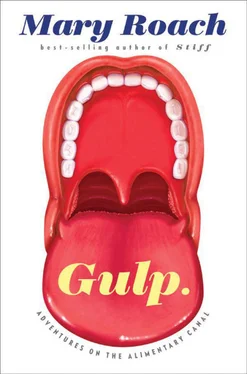Levitt published thirty-four papers on flatus. He identified the three sulfur gases responsible for flatus odor. He showed that it is mainly trapped methane gas, not dietary fiber or fat, that makes the floater float. Most memorably, to this mind anyway, he invented the flatus-trapping Mylar “pantaloon.”
“Even now,” he says of his flatus work, “it overshadows everything else I do.” Levitt and I are sitting in a conference room upstairs from his lab at the Minneapolis VA Medical Center. Levitt has a goofy, lopsided smile and a pale complexion. I couldn’t recall, while writing this, whether his hair was gray, so I typed his identifiers into Google Images. A photograph of a can of baked beans came up.
For the record, here are some of Michael Levitt’s other contributions to medicine: He invented the breath hydrogen test, which originated not as a flatulence assessment technique but to diagnose malabsorption of carbohydrates in the small intestine. He debunked a diet fad for foods made with “nonabsorbable” carbohydrates. He showed that the wriggling movements of the villi are the key to intestinal stirring and to healthy absorption of nutrients. “I wrote the book on intestinal stirring.”
After what I judge to be a sufficient number of follow-up questions on intestinal stirring, I ask whether it might be possible to see the Mylar pantaloons.
Levitt designed the garment for a pair of studies that aimed both to identify the gases responsible for noxious flatus and to test devices claiming to adsorb—the formal term for binding to something’s surface—those gases. He doesn’t know where they are stored, but digs out a photograph of a woman standing in the lab, modeling them. Shown uninflated, they fit more snugly than I’d pictured them. The material is silver, crinkly, and reflective. They’re the sort of clothes baked potatoes wear.
I ask Levitt whether it was difficult to recruit volunteers for the flatus studies. It wasn’t, partly because the subjects were paid for their contributions. People who sell their flatus are more or less the same crowd who turn up to sell their blood.
“What was hard,” Levitt says, “was finding the judges.” Levitt needed a pair of odor judges to take “several sniffs” and rate the noxiousness—from “no odor” to “very offensive”—of each of the sixteen people’s flatal contributions. [89] It could be worse. In a study of malodorous dog flatulence carried out at the Waltham Centre for Pet Nutrition in Leicestershire, England, the far end point of the scale was “unbearable odor.”
The hypothesis was that noxiousness would correlate with the combined concentrations of the three sulfur gases. And it did.
Curious as to which olfactory notes the different sulfur gases contributed to the overall bouquet of flatus, Levitt purchased samples of the three gases from a chemical supply house. The judges agreed on the following descriptors: “rotten eggs” for hydrogen sulfide, the gas with the strongest correlation to stink; “decomposing vegetables” for methanethiol; and “sweet” for dimethyl sulfide. Though lesser players like methylmercaptan contribute as well, it is for the most part these three notes, in subtly shifting combinations and percentages, that create the infinite olfactory variety of human flatus. To quote Alan Kligerman, “A gas smell is as characteristic of a person as a fingerprint is.” But harder to dust for.
The great variety of flatus smells—from person to person and from meal to meal—presented a quandary for the second phase of the study, the evaluation of various odor-eliminating products. Which—whose—wind should represent the average American’s? No one’s, as it turned out. Using mean amounts from chromatograph readouts as his recipe and commercially synthesized gases as the raw ingredients, Levitt concocted a lab mixture deemed by the judges “to have a distinctly objectionable odour resembling that of flatus.” He reverse-engineered a fart. This “artificial flatus” was put to work testing a variety of activated-charcoal products: underwear, adhesive-backed underwear pads, and chair cushions. (Activated charcoal is known to be effective at binding sulfur gases. The circulating air supply in NASA spacesuits is filtered with activated charcoal, lest astronauts’ flatus be blown across their face three times a minute for the remainder of the spacewalk.)
In a separate study to simulate real-life gas-passing conditions, Levitt taped a tube beside the subject’s anus, beneath the charcoal pad or underpant and the subject’s pants. (Cushions were strapped in place.) The subject then pulled the Mylar pantaloons over whatever product was being tested, and an assistant duct-taped the cuffs and waistband to the skin. Levitt hit a switch, and just under a half cup (100 milliliters) of synthesized flatus shot through the tube for two seconds—Levitt’s best guess for the size and life span of a typical fart. “Immediately following gas instillation,” wrote Levitt in the final paper, “air inside the pantaloons was constantly mixed via vigorous palpation over a 30-second period.” Levitt claims to have no video footage. Last, a syringe was fitted into a port in the Mylar to withdraw the gas, and Levitt measured the sulfur gases the charcoal had failed to trap.
The challenge, it turned out, lies in bringing the gas fully into contact with the charcoal—easy with an airtight spacesuit, less so a business suit. Seat cushions were relatively useless, most products trapping a scant 20 percent of the sulfur gases. The underwear pads delivered a 55 to 77 percent reduction, their efficacy compromised by “rectal gas blow-by”: the tendency of the wind to glance off the pad and out the sides rather than penetrate it. The seventy-dollar briefs performed best, adsorbing virtually all sulfur gases, though it was unclear how many wearings they were good for. And given the cost, in terms of both cash and self-esteem, they would seem to have a limited market.
• • •
AS AN ALTERNATIVE to wearing activated charcoal or gluing it to your underpants, you could swallow some pills. But don’t bother, because Levitt has done a study on this too. Activated charcoal pills did not “appreciably influence the liberation of fecal gases.” Levitt surmised that the binding sites were saturated by the time the charcoal made it to the rectum.
Bismuth pills, on the other hand—and Levitt has tested these too—reduce 100 percent of sulfur gas odor. Bismuth is the bism in Pepto-Bismol. Daily doses of Pepto-Bismol can irritate the gut, but not bismuth subgallate, the active ingredient in Devrom “internal deodorant” pills.
I had never before heard of Devrom. This may be because mainstream magazines often refuse to run the company’s ads. [90] The exception being the Saturday Evening Post . The Post has a robust tolerance for graphic medical copy, as evidenced by the November 2011 article “Lumps and Bumps on Your Pet: What Could They Be?”
Devrom’s president, Jason Mihalopoulos, e-mailed me a full-page ad he had hoped to run in Reader’s Digest and AARP magazine. A smiling gray-haired couple stand arm in arm below the boldface headline “Smelly Flatulence? Not since we started using Devrom!” Mihalopoulos was told he could not use the phrases smelly flatulence and stinky odor or the word stool . One of the magazines suggested changing the copy to say that the product “eliminates intestinal gas,” but that’s not what Devrom does. That’s what Beano does. So unless you read the Journal of Wound Ostomy & Continence Nursing [91] These nurses deserve a special award that is difficult to picture.
or the International Journal of Obesity Surgery, you won’t see the happy, internally deodorized Devrom couple.
Читать дальше












